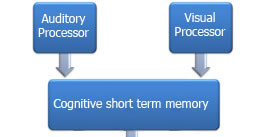5. Cognitive processing

Moving on with the model, outputs from the audio and visual processing is stored in a combined 'cognitive short term memory store'. Remember, all this is happening within less than a second after the inputs have happened.
The 'cognitive' part means that we begin to combine multiple information streams in memory to form a more rounded view of what is happening.
This is why an interface should not provide conflicting/jarring information such as a warning message popping up at the same time as a positive sound.
The technical term is 'cognitive dissonance', which means an uncomfortable feeling caused by holding two conflicting ideas at the same time.
Note that short term memory capacity is quite limited - you can usually hold up to about seven elements. For instance a 7 digit telephone number. So as an interface designer, keep the number of things to be remembered very low.
Time limitations are also important.
Unless a sequence of actions has been committed to long term memory, it will only be remembered for a short time, unless the HCI designer gives the user a reminder of what they need to do.
challenge see if you can find out one extra fact on this topic that we haven't already told you
Click on this link: Cognitive short term memory
